

The vibration engraving machine processing process involves the following steps:
1. Place the material to be cut on a fixed workbench and adjust the position of the workbench to accommodate the placement of the material.
2. Start the device and perform idle confirmation. Once there are no abnormalities, proceed to the next step of operation.
3. Set relevant parameters based on the material and cutting depth, including amplitude, frequency, and process indicators such as cutting speed. These values need to be controlled throughout the entire processing process to ensure a balance between quality and efficiency.
4. Use preset energy for actual cutting. If problems such as overload or stagnation are found, it is necessary to reduce the power output in a timely manner and continue to observe the status to ensure safe operation.
5. Check and proofread completed works to ensure that their quality and shape meet expected requirements. If necessary, edge burrs or surface defects can be appropriately trimmed.
6. End the daily production task after completing a series of cleaning and maintenance tasks. It is important to regularly maintain and inspect the wear and tear of each component, and promptly replace vulnerable parts to ensure the long-term stable operation of the equipment.
7. Repeat the process according to different needs until the required quantity and quality level are reached before stopping the operation.
This method is suitable for the production and use of most plastic products, but it is important to understand the possible limiting factors and adjust and optimize according to the actual situation to meet the performance goals under specific conditions..


